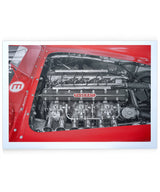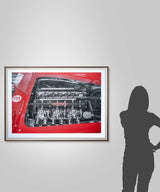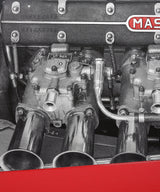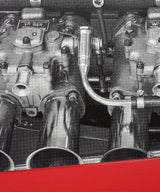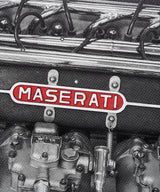A limited edition of 200 fine art screen prints created by artist and photographer Alan Thornton. Alan has taken a fine example of the 300S into the studio and shot it beautifully at very high resolution on a large format camera. With his London based team using hand pulled screen printing, he has rendered the image onto Naturalis paper, made in England, at a large size: 1.0 metres wide and 0.7 metres high. Alan has used spot colours to maximise the intensity of the image and the result is an imposing and incredibly beautiful art print, that fully delivers the elegance and engineering virtuosity of this Italian beauty.
- Limited to just 200 prints
- 100cm tall by 70cm wide
- Original photograph of the Maserati 300S was studio shot by artist Alan Thornton
- Fine art, hand-pulled silkscreen prints
- Utilises water-based inks, printed onto 400 gsm Naturalis paper, made in England
- Created by artist and photographer Alan Thornton
This fine art screen print is of the engine of the Maserati 300S. Widely considered to one of the finest handling front-engined sports cars of all time, the 300S was initially developed using the 2.5 litre straight-six engine fitted in the 250F Grand Prix racer, before the engineers soon discovered that this was underpowered compared to their rivals at Ferrari and Jaguar. Development of a larger version was started, eventually creating a three-litre capable of producing 245 bhp. Though more time-consuming to build, the car’s intricate and advanced tubular space frame design was both light and stronger than a conventional chassis. The car benfutted from double wishbone suspension with vertically mounted coil springs over dampers at the front, whilst at the rear a sophisticated DeDion axle was fitted, complete with a transverse semi-elliptic leaf spring and hydraulic dampers. The transverse gearbox was mounted in unit with the differential, which added some more load to the rear wheels. Large, finned drums provided the 300S with sufficient stopping power. The car’s balance and handling drew praise far and wide and for many drivers, such as the great Sir Stirling Moss, it was a favourite. In the hands of the right racers, the 300S could get around a circuit quicker than many larger-displacement competitors. Piloted by prestigious racers like Juan Manuel Fangio, Moss, Luigi Musso, Briggs Cunningham, Jean Behra, Roberto Mières, Masten Gregory, Piero Taruffi, Cesare Perdisa, Hans Herrman and Carroll Shelby, the 300S race with great success and firmly earned its position in the annals of sportscar history.
The Process
Screen printing is the process of transferring a stencilled artwork onto a flat surface using a mesh screen, ink and a squeegee. Starting with the photography, the subject matter is composed and lit with the intermediate processes and the final print in mind - each step very much influences the final outcome. In post-production the image is refined and manipulated to create the final tonal variations needed for the separation of colours, which are then half toned which simulates continuous-tone imagery through the use of dots or lines, varying either in size or in spacing, thus generating a gradient-like effect. For each colour, a positive acetate is transferred to a silk screen frame coated in photosensitive emulsion. Following exposure, washing out and drying, the frame is mounted on a to print bed, and the chosen colour ink is then forced through the mesh with a squeegee by hand. This is a highly skilled craft process, sensitive to the touch, feel and technique of the printer, and as a result each print is unique.






